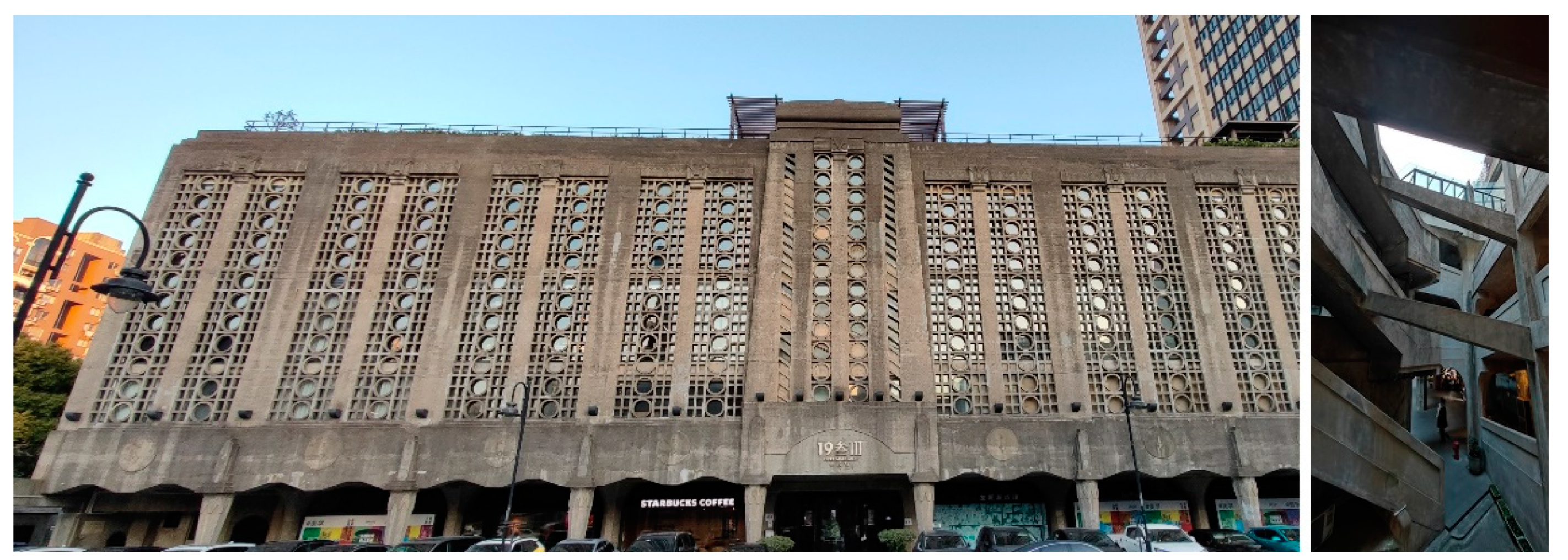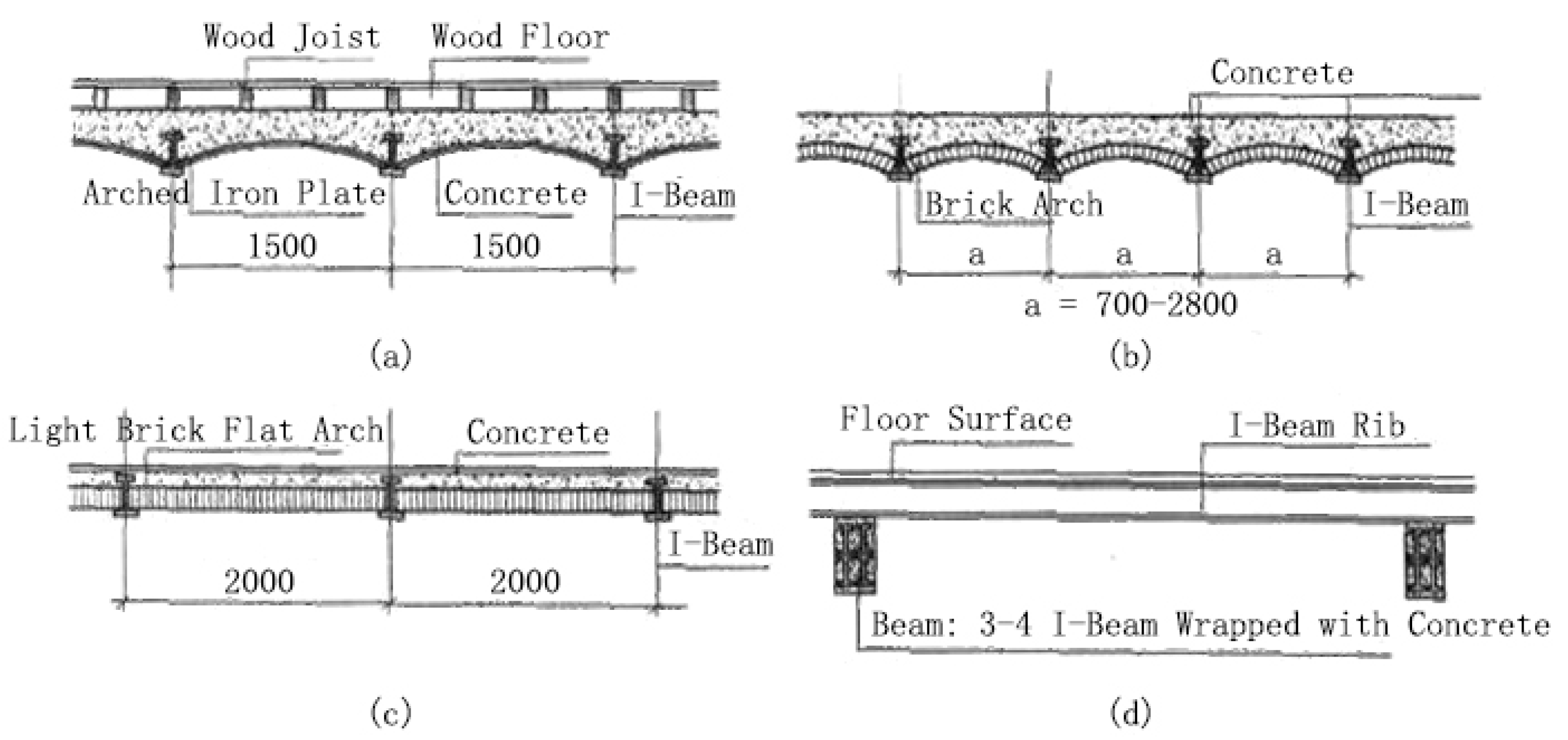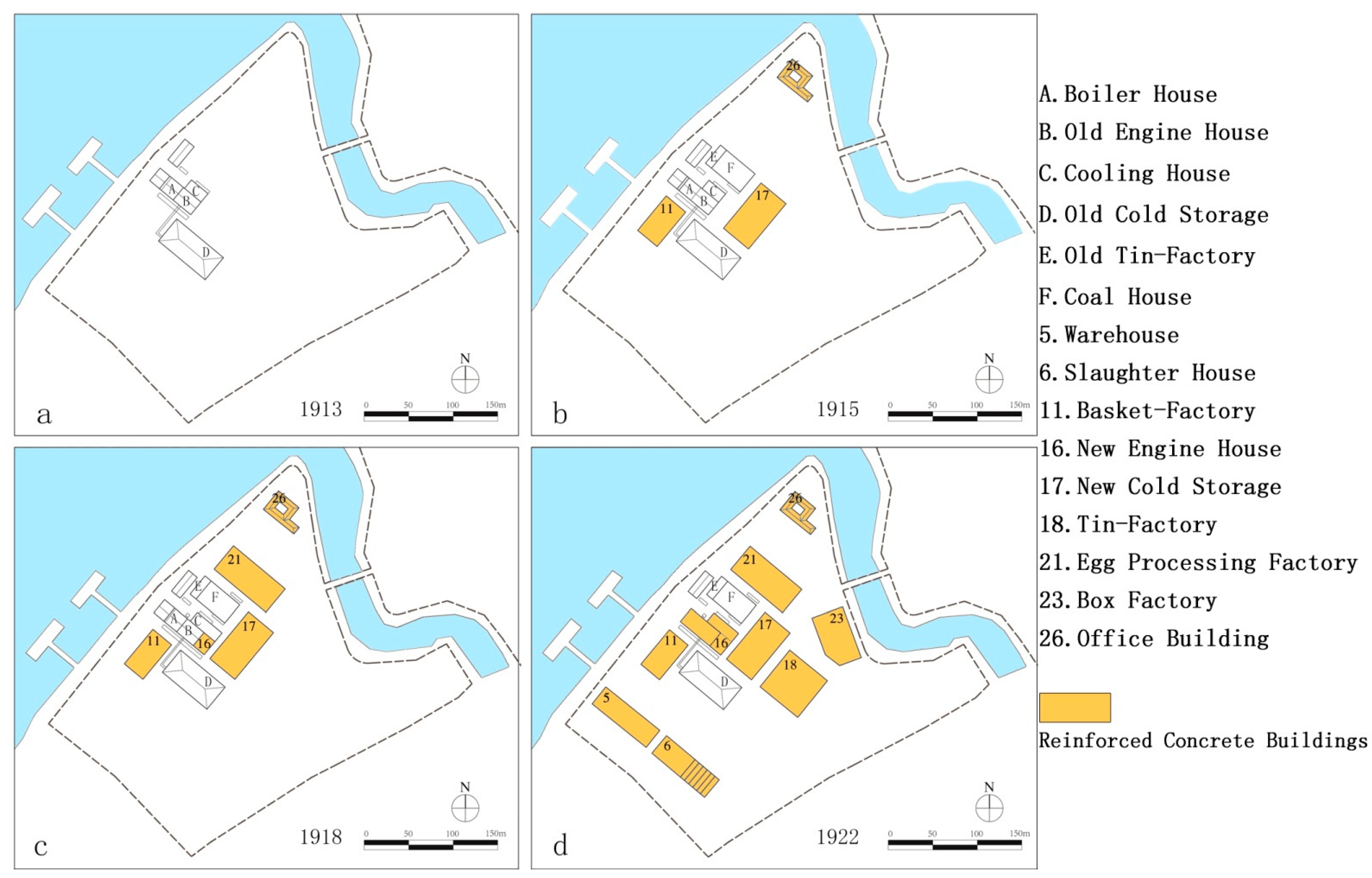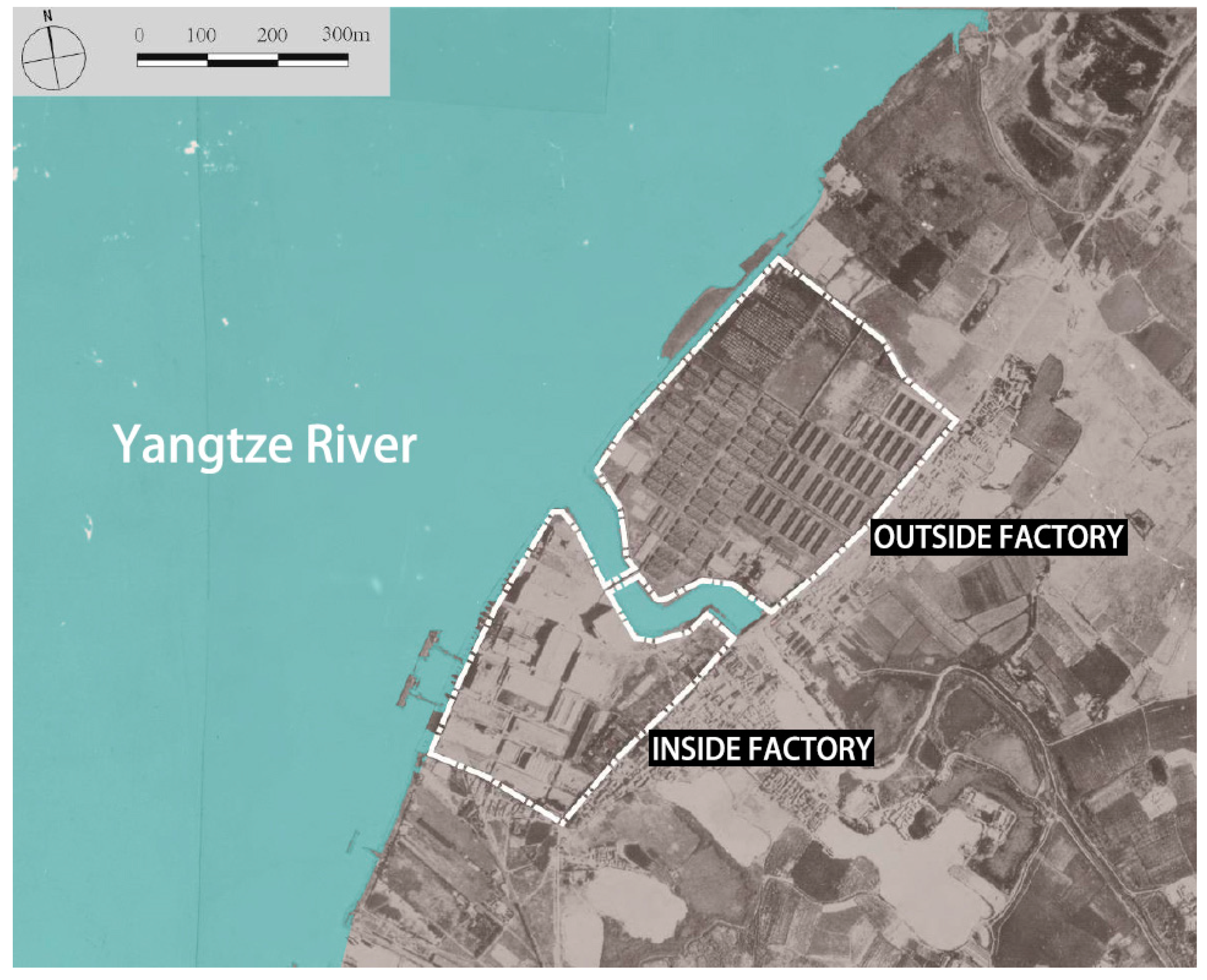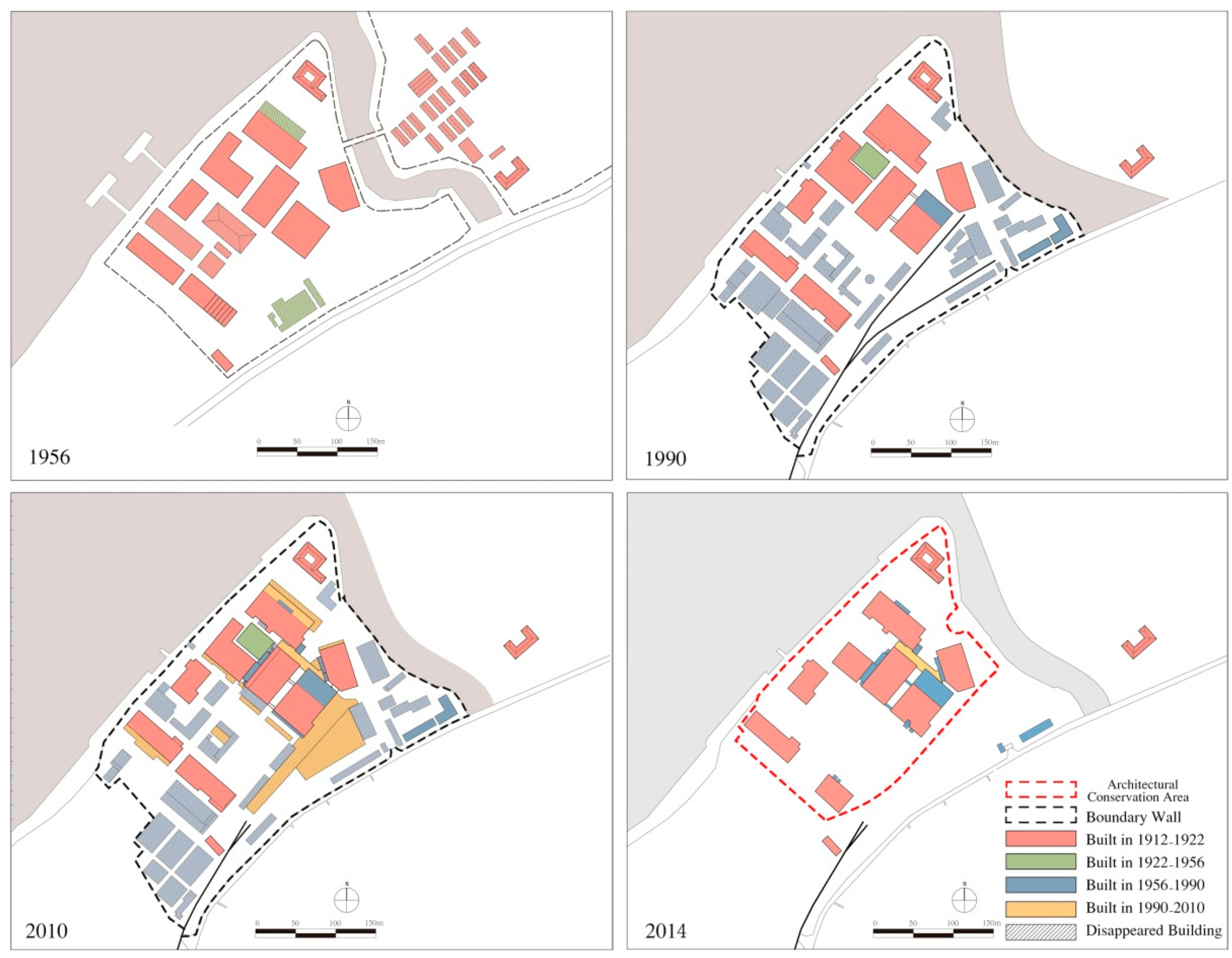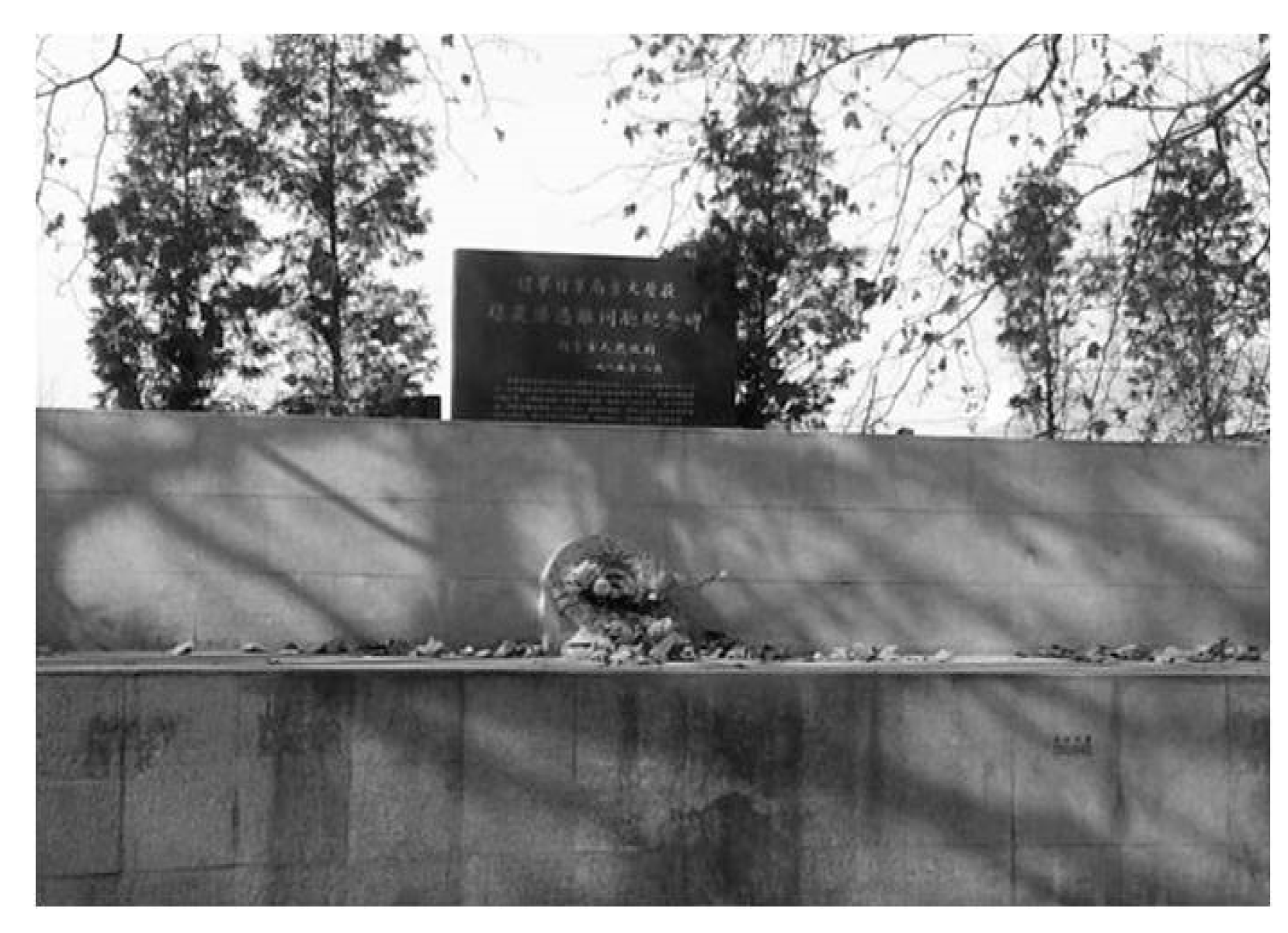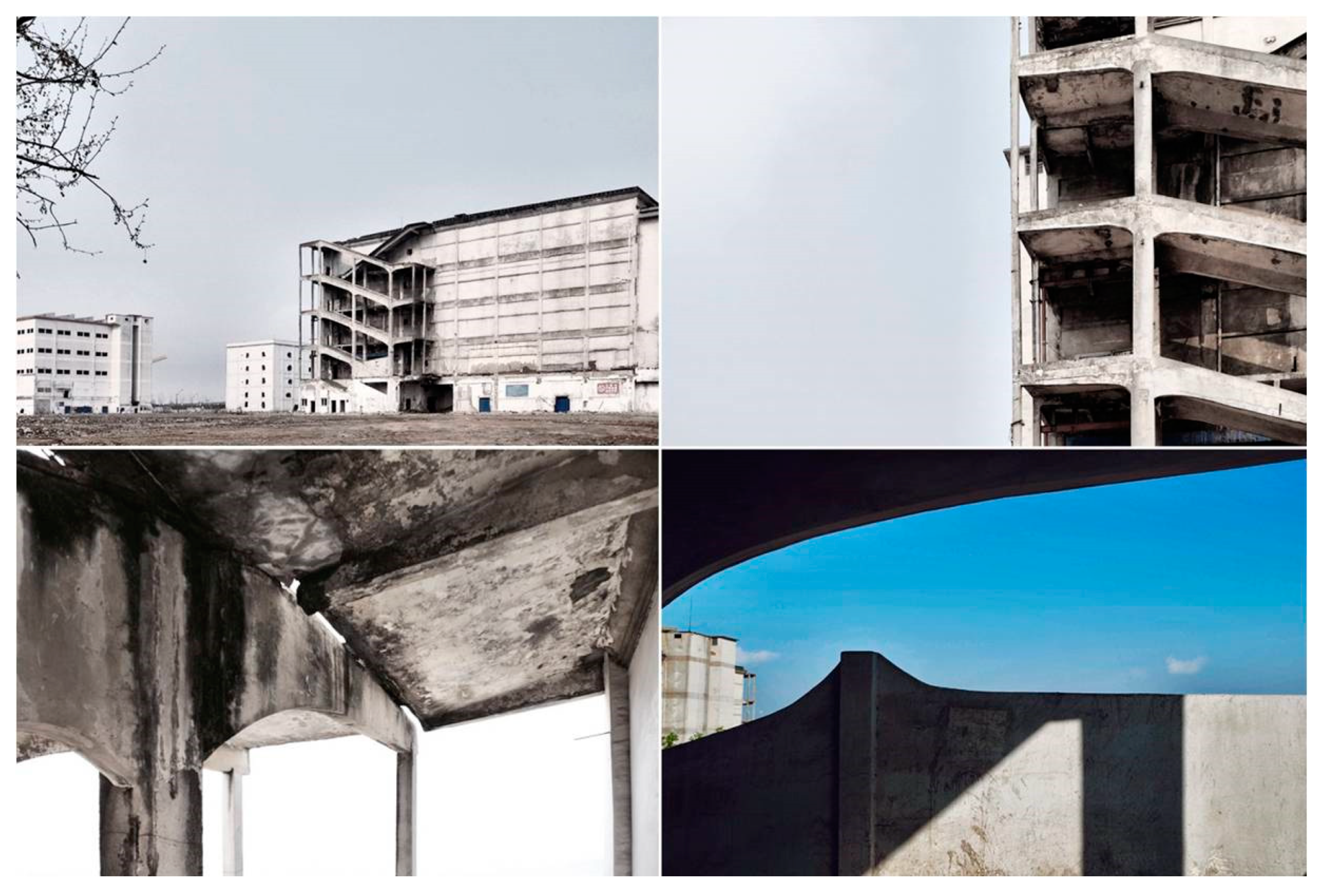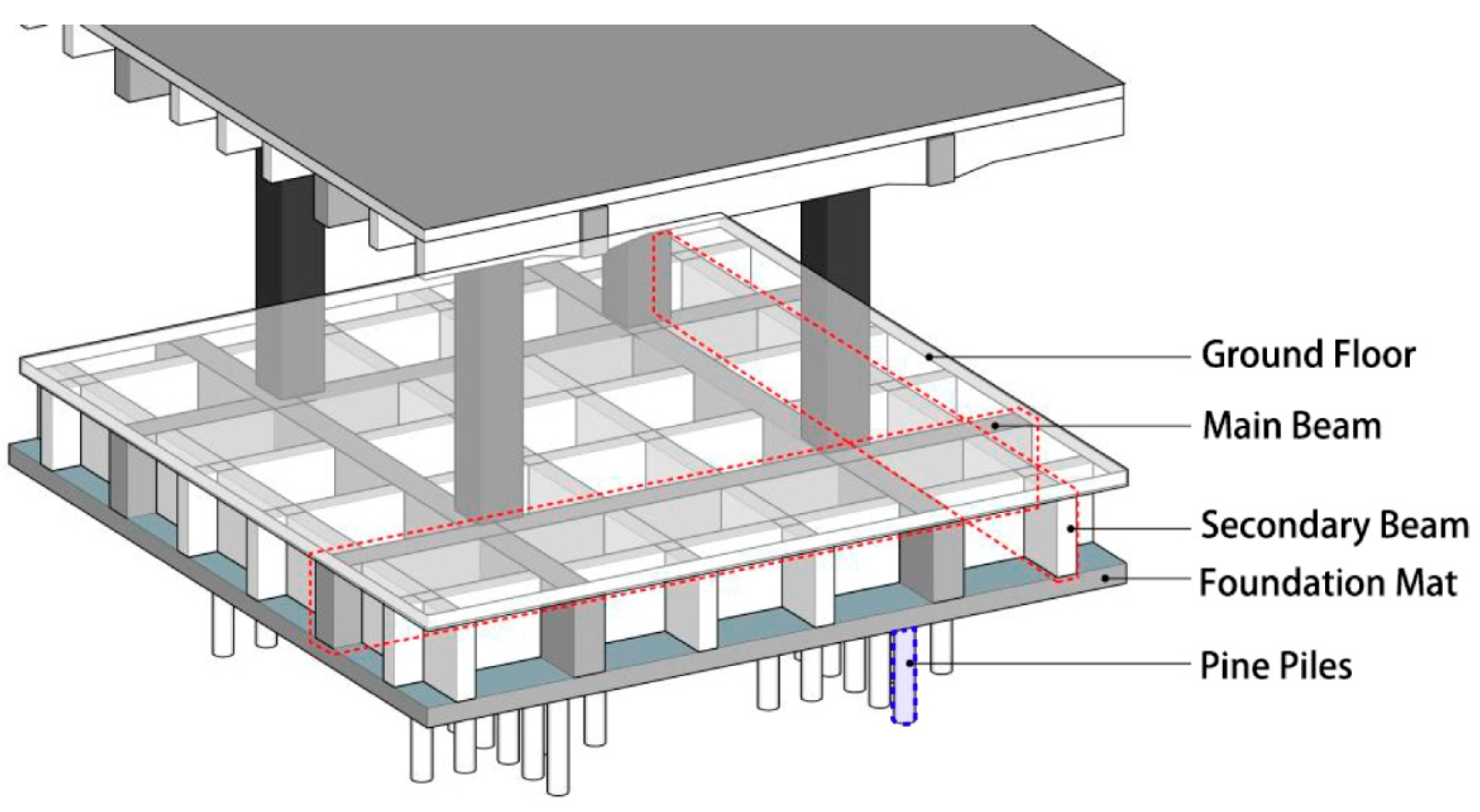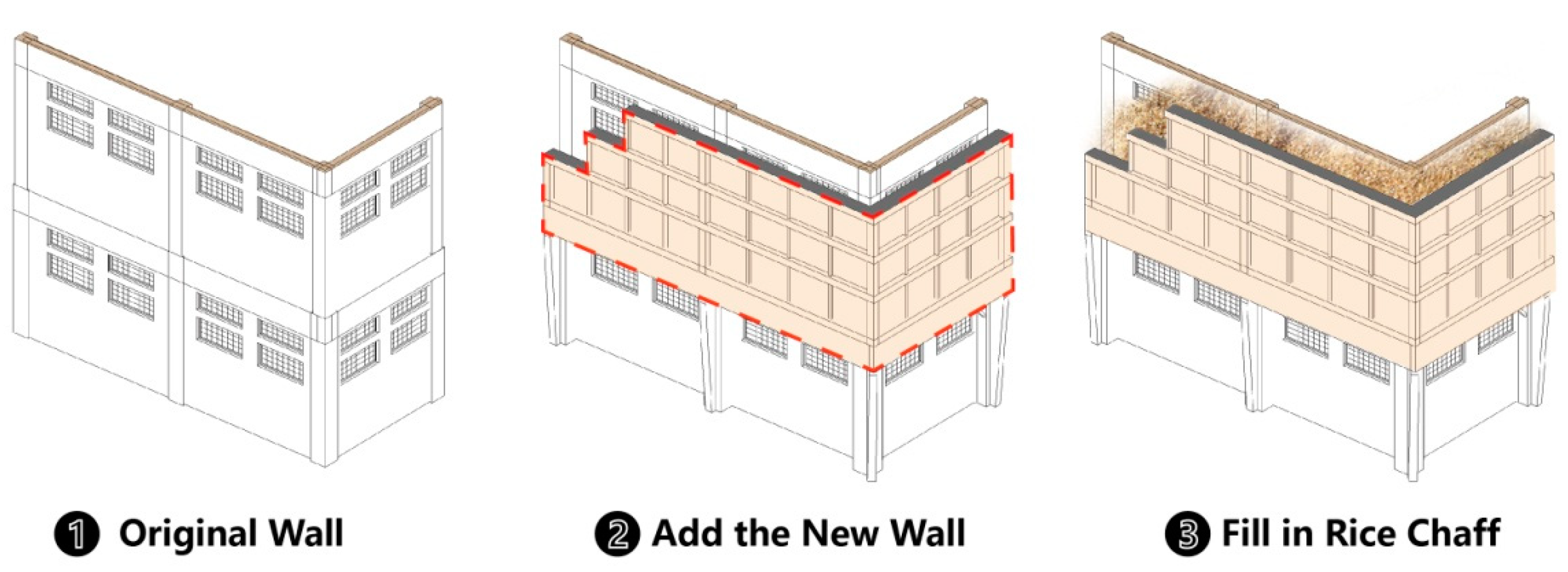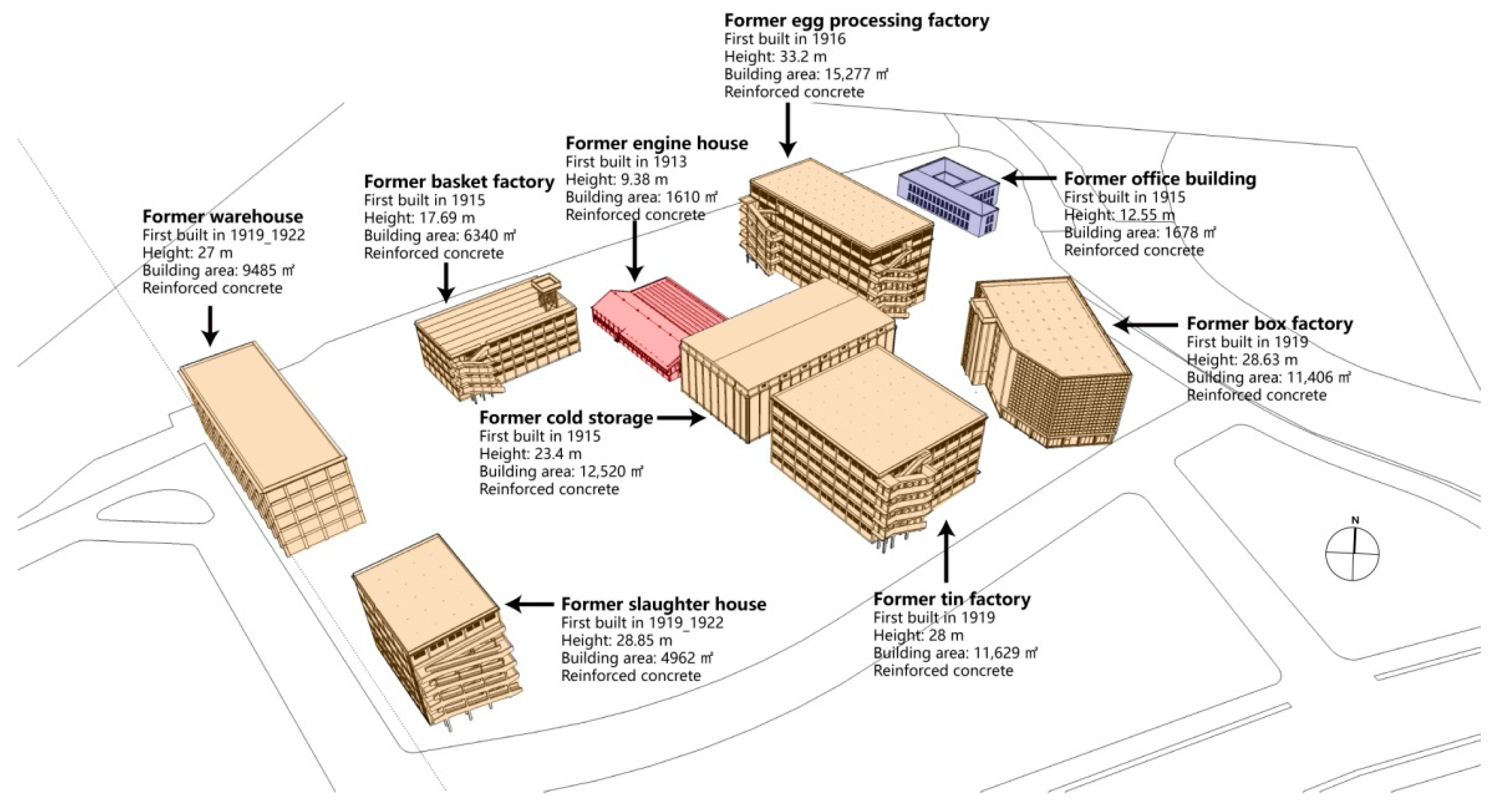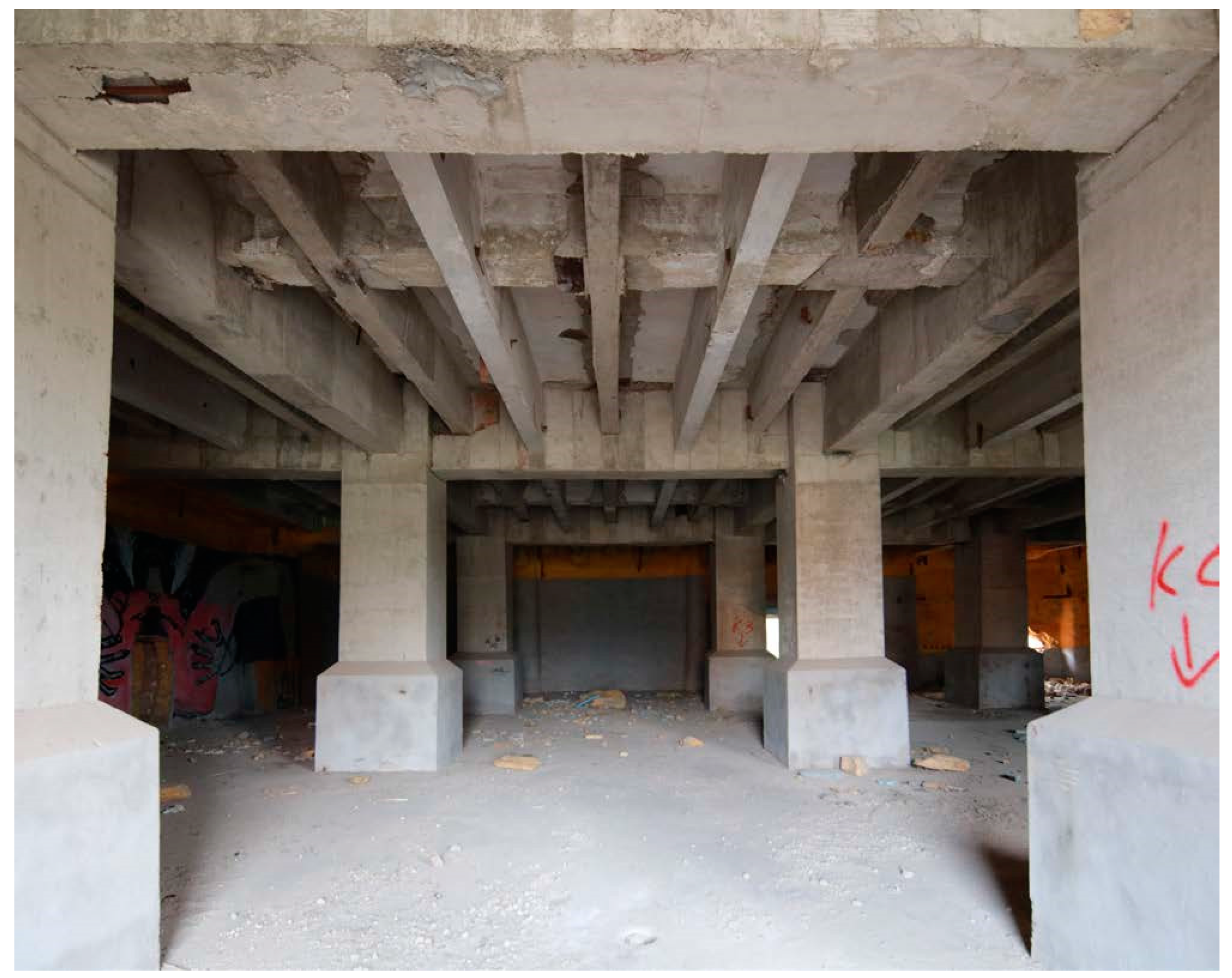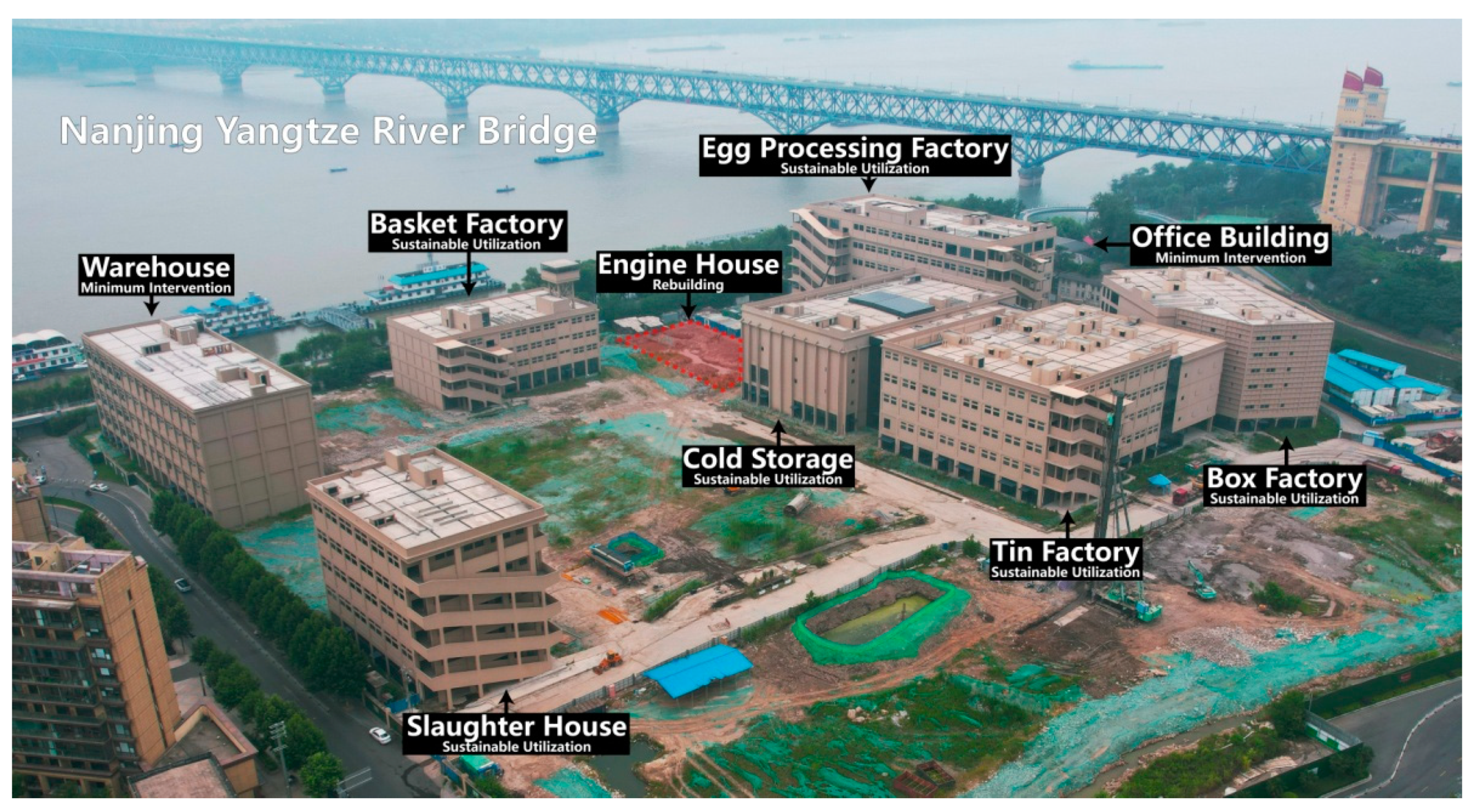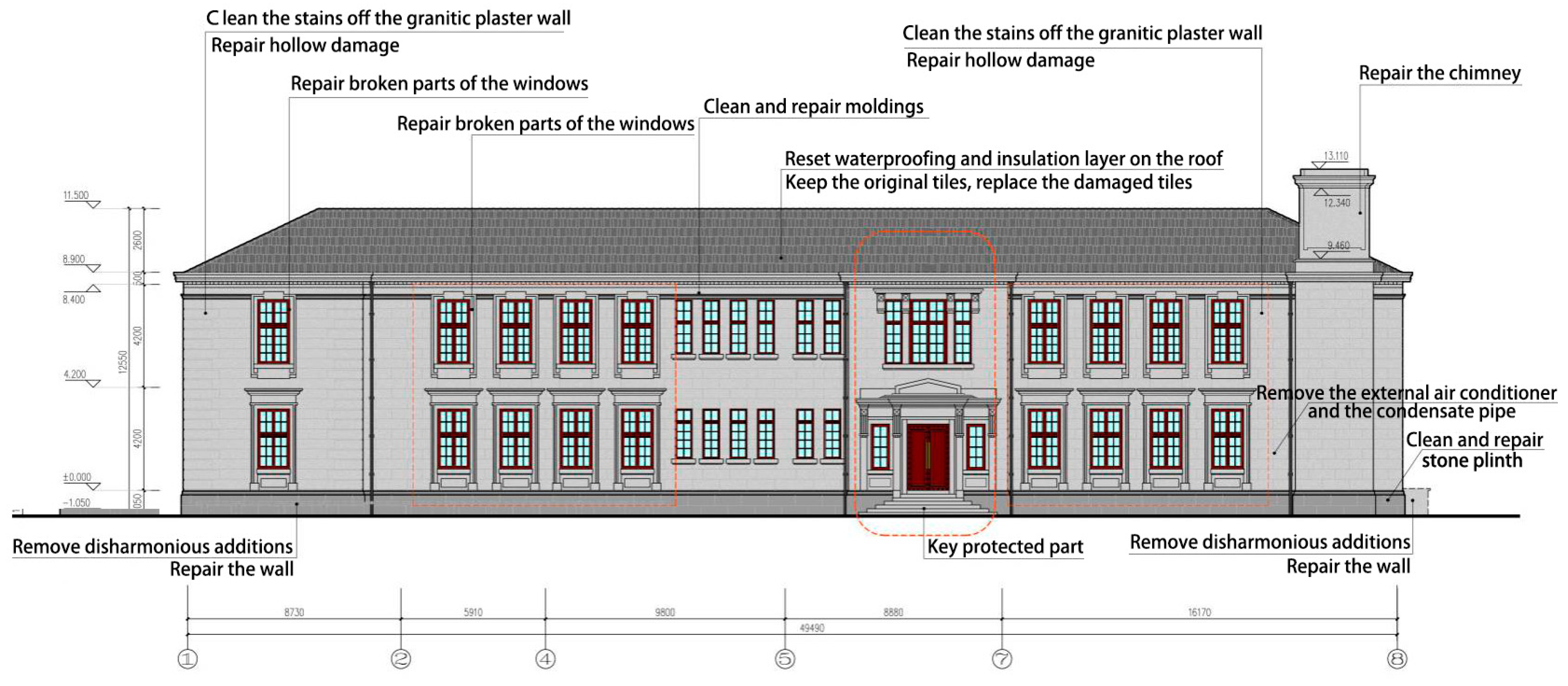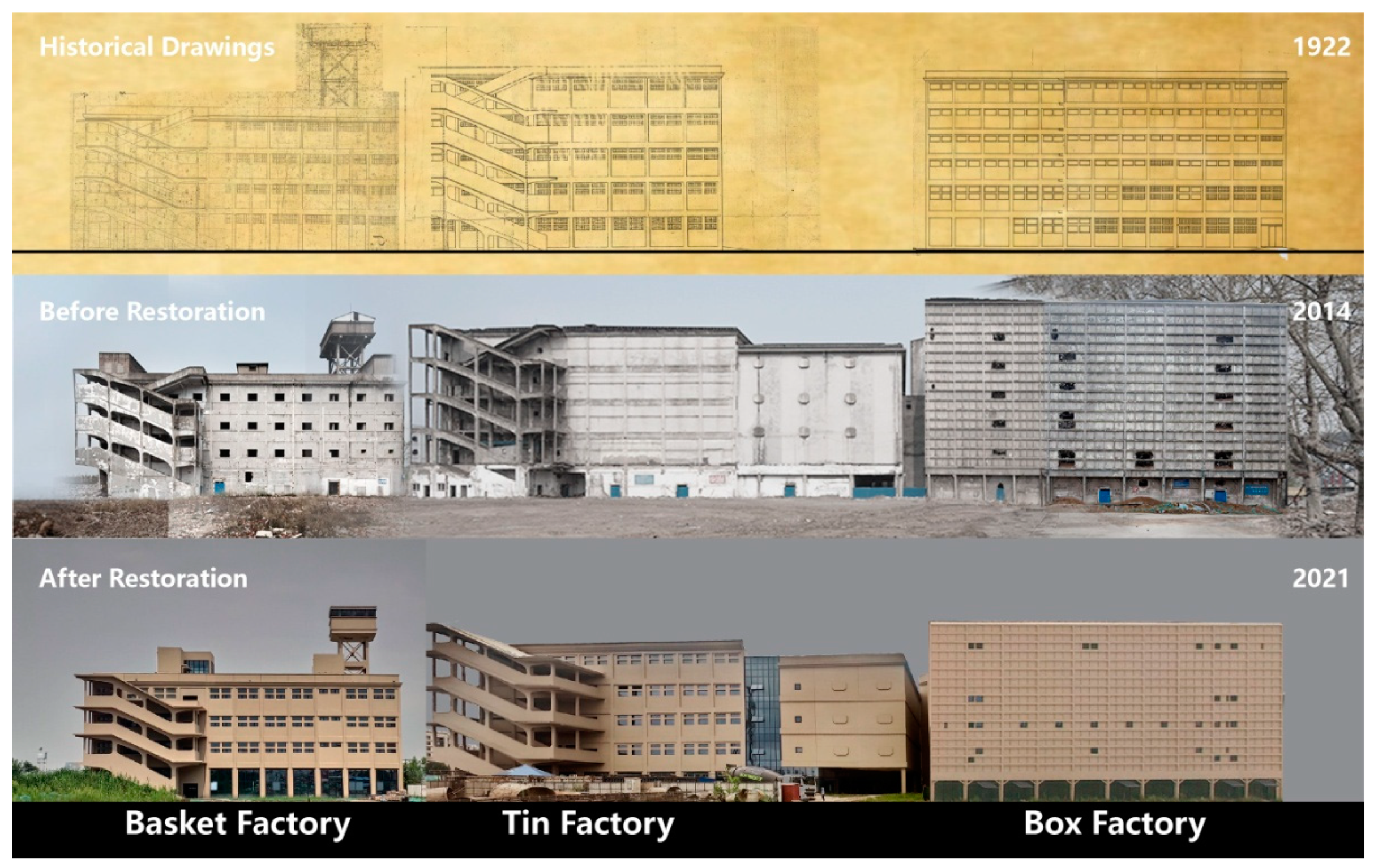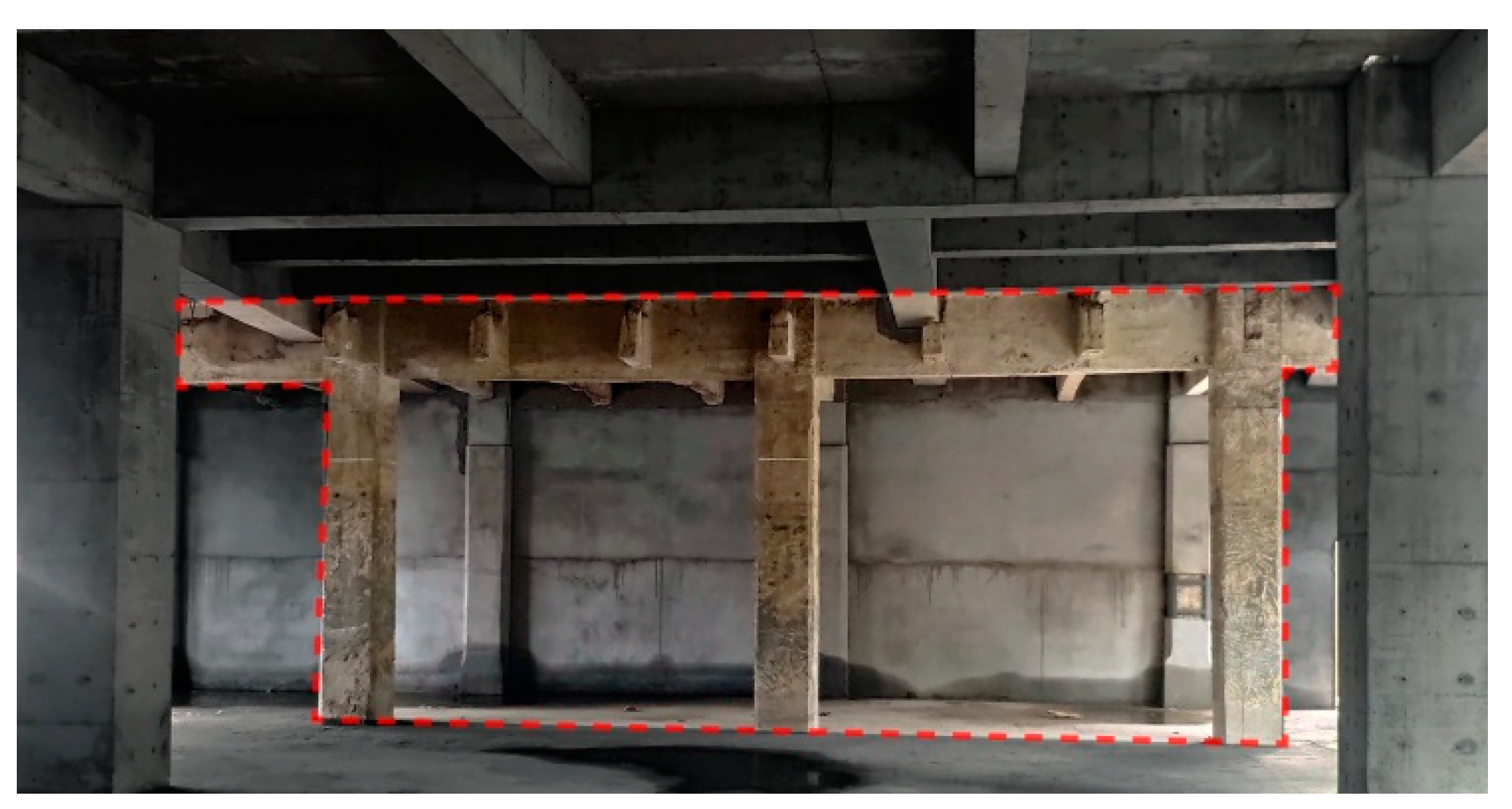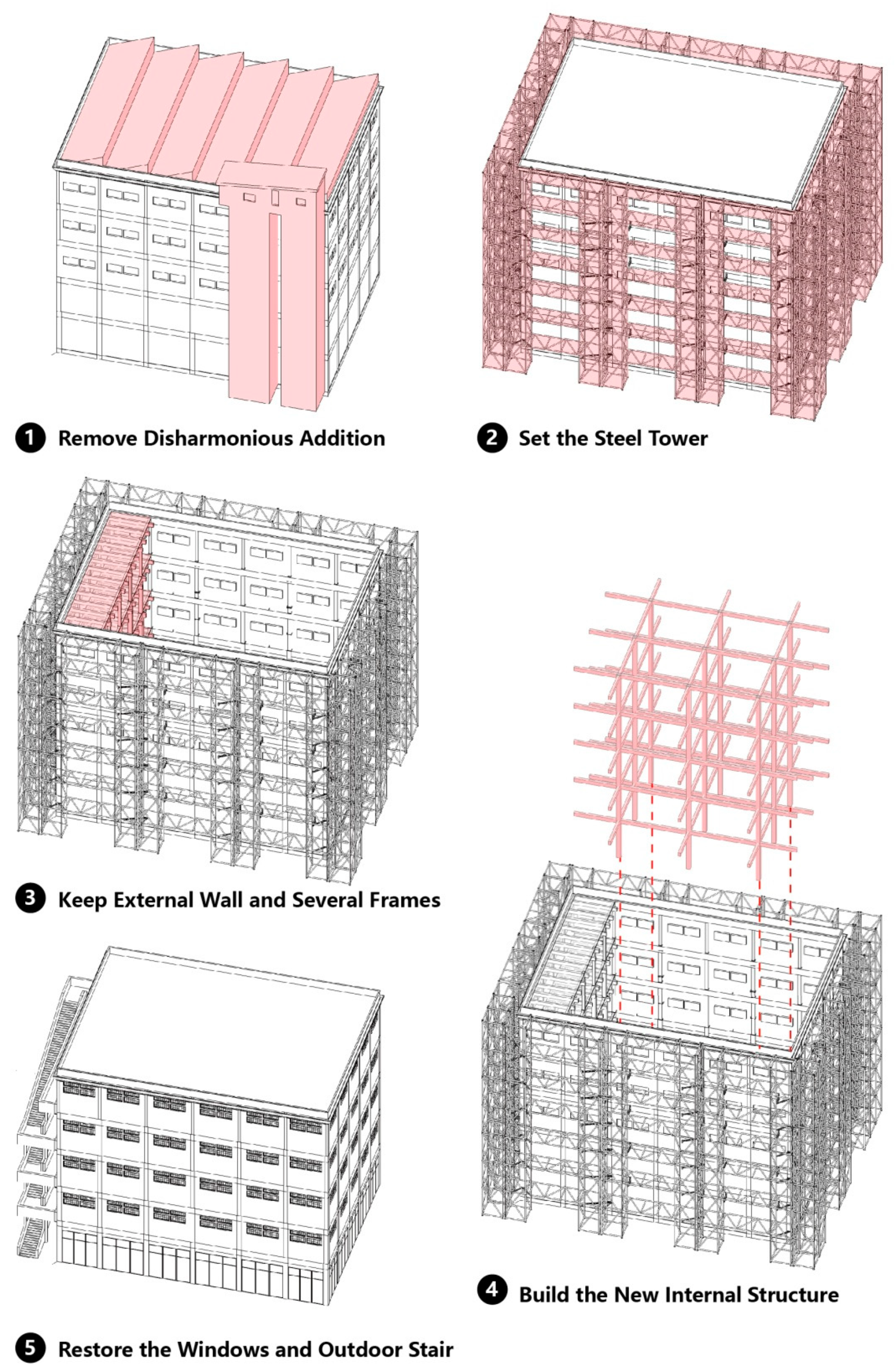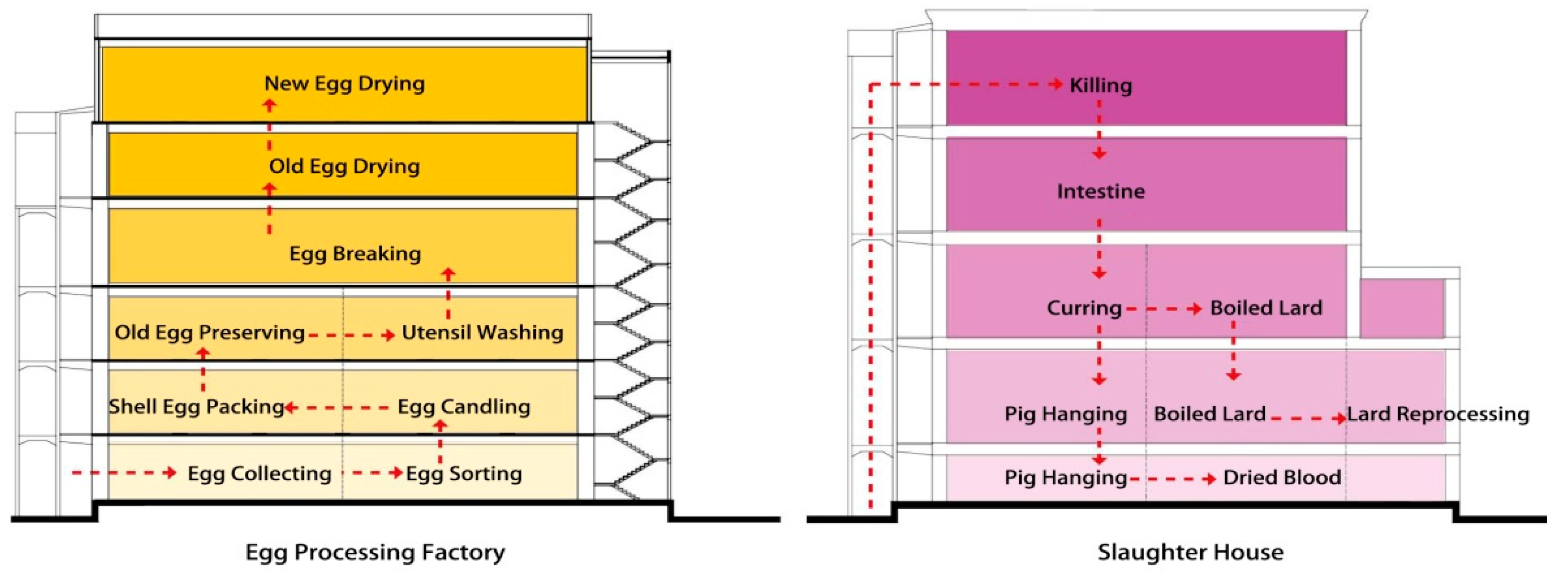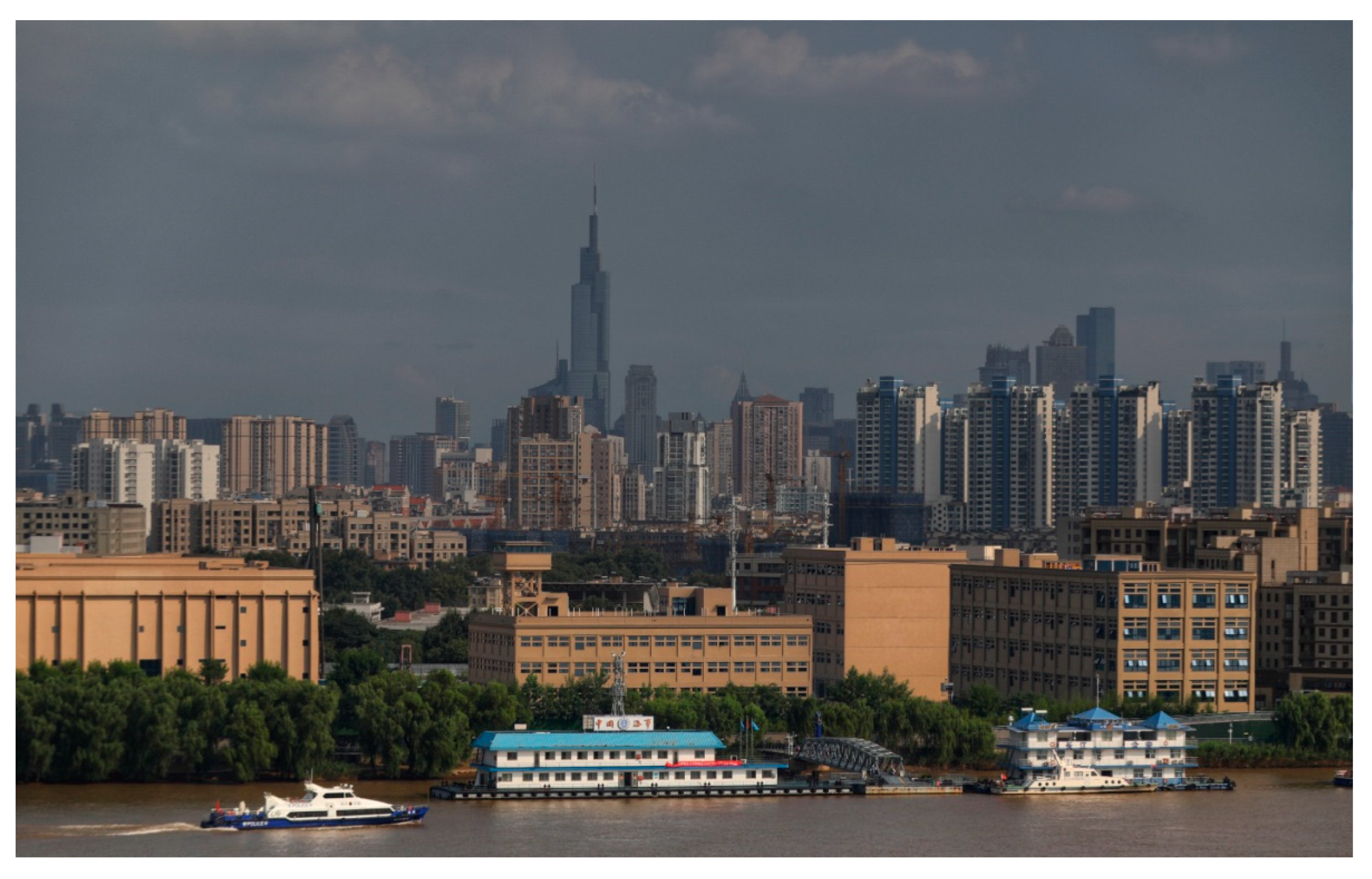1. Introduction
At the end of the 19th century, concrete first entered China as a brand-new building material, and, subsequently, reinforced concrete structures were gradually popularized and widely constructed [
1]. During that period, China erected many industrial buildings that were influenced by advanced Western technology and used mechanical and dynamic equipment [
2]. Reinforced concrete technologies suited the characteristics of large-scale industrial buildings. As a result, the earliest reinforced concrete industrial buildings in China came into being.
These reinforced concrete industrial buildings have been used for a long time, generally exceeding their normal service life, and have different degrees of durability problems. On the one hand, these buildings are of great value as historical buildings and played a large role in the production of the national economy, so they need to be utilized. On the other hand, they have potential safety hazards and their scale also restricts revitalization.
The International Export Company (Kiangsu) (IEC (Kiangsu)) is located near the Yangtze River in Nanjing. It has a history of more than 100 years. It is not only the earliest large-scale industrial building group in Nanjing but is also the reinforced concrete building group with the longest history. In 2014, planning for the new Yangtze Riverside Business District was officially launched by the city government, for which all aspects of construction were advanced step by step. As a significant part of this project, the former International Export Company area was facing a comprehensive transformation and functional upgrading to keep pace with the overall development of the entire Yangtze Riverside Business District [
3]. The authors participated in the preservation and revitalization project of the IEC (Kiangsu).
Industrial heritage is unique. Once they lose their vitality for use, their value will also decrease. Since the 21st century, more and more outstanding industrial buildings in China have moved from being idle and decaying to active and dynamic protection and reuse [
4]. For example, the abattoir of S.M.C.P.W.D (1933 Old Millfun), which was built in 1933, was the largest modern abattoir in the Far East at that time. The renovation project attempted to revitalize the abandoned industrial heritage and transform it into a fashion center. During the protection and revitalization, the original structural system was retained, and the damaged parts were repaired according to the original process and materials [
5] (
Figure 1). The revitalization of the abattoir has achieved a win–win situation in many aspects: the government has obtained the opportunity to improve the appearance of the region, the local tax has been increased, the owners have increased the rental income, and the idle plant resources have been revitalized [
6].
Outside of China, we have also seen revitalization of industrial heritage being widely discussed and practiced. Sir Neil Cossons stated that “Industrial heritage is, arguably, a unique cultural discourse; it brings challenges found nowhere else in the heritage sector and requires new answers” [
7]. Faced with this unique cultural discourse due to their large-open spaces, adaptive reuse should be the preferred strategy for an industrial building when no other industrial option is available [
8]. In the functional adaptation of the industrial architectural heritage of Berlin, Germany, different treatment methods can be seen, such as only retaining the exterior wall and rebuilding other structures; combining the old and new with demolition, retention, modification, and expansion; and demolition and modification to restore the original appearance of the space [
9]. Another famous case of reinforced concrete industrial heritage was the Lingotto Factory Conversion in Italy by Renzo Piano. The project had two objectives: to revive the factory by transforming it into a multipurpose center and to maintain its architectural identity [
10].
3. Discussion of the Principles of Preservation and Revitalization
3.1. Theoretical Basis
The IEC (Kiangsu) had a history of one hundred years. It had undergone many years of construction and then changed its owner. By the time our team started to design, the remaining buildings had different styles and scales. Based on the complex situation, we needed to use value evaluation to determine the principles of preservation and revitalization of the overall environment and single buildings.
The diversity of heritage values has long been recognized. As early as 1933, the Athens Charter stated the value of heritage as follows: “The grounds for the preservation of buildings should be that they express an earlier culture and that their retention is in the public interest” [
34]. The Venice Charter in 1964 mentioned that, “Imbued with a message from the past, the historic monuments of generations of people remain to the present day as living witnesses of their age-old traditions,” and “The concept of an historic monument embraces not only the single architectural work but also the urban or rural setting in which is found the evidence of a particular civilization, a significant development or an historic event” [
35].
In 1982, the Chinese government promulgated the Law of the People’s Republic of China on the Protection of Cultural Relics, which was the first law regarding the protection of cultural relics after the founding of the People’s Republic of China. Article 13 of Chapter II “Immovable Cultural Relics” of the law states: “The administrative department for cultural relics under the State Council shall select sites from among the ones protected for their significant historical, artistic or scientific value at the provincial, city or county level and designate them as major sites to be protected for their historical and cultural value at the nation level, or shall directly designate such major sites, and report them to the State Council for verification and announcement” [
36]. The Law of the People’s Republic of China on the Protection of Cultural Relics adopts three aspects of the recognition of cultural heritage value in the traditional view.
In addition to these traditional values, The Burra Charter in 1979 added social or spiritual value. In recent years, both international and domestic have paid attention to the strong contemporary effects of cultural heritage [
37]. The terms “social value” and “cultural value” have gradually been accepted by the academic community and adopted by the 2015 edition of the “Principles for the Conservation of Heritage Sites in China” [
38]. However, judging from the writing of the “Principles for the Conservation of Heritage Sites in China”, these two values exist as supplements to the three traditional values, not the fourth and fifth values that are juxtaposed with them [
39].
Specific to the industrial heritage, in the Nizhny Tagil Charter in 2003, industrial heritage was defined this way: “Industrial heritage consists of the remains of industrial culture which are of historical, technological, social, architectural or science value” [
40].
The particularity of industrial heritage is that it usually has a large scale, which determines that we cannot protect it as an “exhibit” and ignore the use value. Doing so will inevitably cause huge waste and economic losses. Thus, we must also pay attention to the discussion of topics other than the heritage value.
At the beginning of the 20th century, Alois Riegl (1858–1905) summarized the value of architectural heritage as “Commemorative Value” and “Present-Day Value” [
41]. He distinguishes three different Commemorative Values in monuments: intentional value, unintentional value (historical value), and age value. Considering other values that a monument offers to modern man, he distinguished Present-Day Values as utilitarian value (use value) and art value. He believed that the preservation of monuments must take this into account, if only because it may have a practical and topical significance quite apart from the historical and commemorative value of a monument. Historic buildings with use value are not just monuments. They have a function that imposes requirements that change over time, and these requirements cut across cultural heritage considerations and inherited age values [
42]. Contemporary scholars have also continued this discussion, as Randall Mason believed that one can think of the broad spectrum of site values in terms of “heritage values” and “contemporary values”. Heritage values are those contributing to the sense of a place being endowed with some legacy from the past—quite literally the stuff in need of preservation. They typically include artistic values tied to the original vision of an artist, as well as those accumulated over time. They also include historical values associated with the site, as well as the scientific or “archeological” values embedded in its material layers. Contemporary values are distinct in that they matter for reasons other than the recovery or retention of cultural significance, but nevertheless are recognized as legitimate values of a site, such as profit, recreational use, ecological integrity, and public health [
43].
In a discussion paper for the Council of Europe, it was argued that heritage matters because “it is part of our quality of life” through shaping places, cultural identity, and memory, and by providing amenity values to the community [
44]. Chinese scholars such as Qing Chang believe that the protection of architectural heritage is not limited to preservation and restoration now, but includes exploring adaptive methods of various historical buildings and environmental preservation and regeneration in urban and rural construction. It should be incorporated into the overall pattern of local social and economic development [
45]. He summarized value as the testimony of important historical events or specific life forms; the representation of the artistic style and technical characteristics of a period; the carrier of emotions, ideas, beliefs, realms, and other conceptual forms; and a space resource.
If we indeed wish for our cultural heritage to have a future, then heritage must be relevant to the present, and that implies it must be relevant to the aspirations of the present-day communities [
46]. Obviously, as a space resource, architectural heritage is oriented to the present and even to the future. The various needs of contemporary society and growing consciousness of the great value of architectural heritage emphasize the importance of revitalization as a means of preservation, but at the same time its activation in the context of sustainable development [
47]. A successful adaptive reuse project should also be economically sustainable [
48]. In the IEC (Kiangsu) project, we tried for this kind of preservation in a broad sense through value evaluation. We tried to find a balance between heritage value and contemporary value. While inserting new functions, it also fully respected the status quo, and the renovation strategy was an adaptive choice after evaluation.
3.2. The Development and Current Situation of the IEC (Kiangsu)
On 25 June 1956, the State Council and the State Planning Commission agreed that the Ministry of Commerce would invest CNY 10 million to rebuild the former site (Inside Factory) of the IEC (Kiangsu) into the Nanjing Slaughtering and Meat Processing Factory. On 1 July 1957, the Nanjing Slaughtering and Meat Processing Factory was put into operation. With the help of Soviet experts, three cold storage warehouses were rebuilt using the original factory buildings [
17].
In 2003, the Nanjing Slaughtering and Meat Processing Factory was restructured and renamed Nanjing Tianhuan Food Co., Ltd. (Nanjing, China) Some additions were carried out in the factory area because of the demand of use, such as the addition of overpasses to connect the cold storages. At this time, roads replaced railways as the main mode of transportation, and the original railroad tracks were no longer used.
In 2014, Nanjing Tianhuan Food Co., Ltd. (Nanjing, China) Moved entirely to Jiangning District, and a large number of buildings built after the 1960s on the site were demolished (
Figure 7).
The architectural function of the IEC (Kiangsu) changed with the needs of different ages, but the architectural layout of the factory area always revolved around the original factories and contained the most important production and storage functions.
Unfortunately, after the preservation and revitalization design began, the Engine House was damaged by a fire.
3.3. Value Evaluation of the IEC (Kiangsu)
Because of the scale of the IEC (Kiangsu) and the spatial function and economic expectations it assumed after its transformation, we explored the value of the IEC (Kiangsu) from the two perspectives of “heritage values” and “contemporary values.”
3.3.1. Heritage Values
From the perspective of “heritage values,” we can refer to the description of the value of industrial heritage in the Nizhny Tagil Charter. It can be seen that, compared with the Law of the People’s Republic of China on the Protection of Cultural Relics, which refers to the traditional definition of heritage value, the definition of industrial heritage in the Nizhny Tagil Charter does not mention artistic value. It explains that “it may have considerable aesthetic value for the quality of its architecture, design or planning” [
40]. The artistic value of industrial heritage is mostly embodied by buildings and structures.
When a certain feature of a building is consistent with the important historical facts of a certain category at a certain level, the building is considered to have historical value. The level of historical value is based on the degree of relevance of the feature to historical facts on the one hand, and on the other hand, it is based on the importance of historical facts [
49].
Because of its intricate relationship with modern history, modern industrial heritage has more sensitive emotional and political effects. It is expressed as a kind of emotion in the collective memory. Its social value is intertwined with its historical value. Therefore, we will consider them together.
As China’s earliest modern enterprise of modern food processing, refrigeration, storage, and sales, the IEC (Kiangsu) had a unique position in China. It was the largest of and had the most advanced technology and the most complete facilities among the food processing enterprises in the country at that time, so it is of milestone significance in China’s modern meat processing industry. It witnessed the complicated competitive relationship between foreign capitalist industry and modern national industry and reflected the exchange and integration of Western culture and local culture in its complex social background. The first IEC (Hankow) was demolished in 2006. The IEC (Kiangsu) was well-preserved, and its historical value was enhanced by the integrity of its preservation and the uniqueness of its type.
In the hundred years of its existence, it has also been witness to the changes, development, and progress of the social milieu. From the semi-colonial and semi-feudal society when it was established to the Republic of China when it was first operated, from the labor movementto the tragic Nanjing Massacre (
Figure 8), then to the rapid modernization of Nanjing after the founding of the People’s Republic of China, the IEC (Kiangsu) experienced war and peace. Then, only the reinforced concrete structure remained, and it had become part of the collective memory of the area and even of the entire city.
At the beginning of the 20th century, China’s reinforced concrete buildings were just beginning to sprout, after which they were rapidly developed and widely used.
“The Architectural Heritage of Modern China” conducted a survey of modern buildings in 16 cities of China. Among the 190 modern buildings in the Nanjing Volume, 122 were reinforced concrete structures, accounting for 64.2% of the total [
50]. However, the early IEC (Kiangsu) industrial buildings that were completely preserved at the huge scale were very rare. At the beginning of the 20th century, China’s reinforced concrete technology was not yet mature. Many materials of the IEC (Kiangsu) were imported from the United Kingdom. The building itself was also designed by foreign architects. It was a testimony to China’s earliest modern reinforced concrete structure at that time. It was also an important example of reinforced concrete technology from its local beginnings.
Its buildings were huge and well-preserved and were typical of the earliest cases of reinforced concrete structure in modern China. The design team of E.J. Muller Consulting Civil Engineer (Shanghai, China) and the construction team of Yao Xin Kee Construction Company (Shanghai, China) reflected the technical level of the time. The most fortunate development for us was that the company still retained the original historical drawings. Through these drawings we could understand the standards and features of the original design and what changes had been brought about by the subsequent transformation (
Figure 9).
In the field of industrial production, the IEC (Kiangsu) was the largest and most modern food processing enterprise of that period in Nanjing, and its production technology represented the highest level of the domestic food processing industry at that time. The Inside Factory maintained its functions of food processing, storage, and transportation from the management and operation of the IEC (Kiangsu) to Nanjing Tianhuan Food Co., Ltd. (Nanjing, China) The original production process and line was continued and preserved to a certain extent. During the operation of the Nanjing Slaughtering and Meat Processing Factory, the basic technological process did not change. Only the use of the buildings had been adjusted according to new demands; for example, some original factory buildings were converted into cold storage and the space for food storage was increased [
51].
A large amount of production equipment had been kept. From generators and compressors to processing equipment, we could see the IEC (Kiangsu) production process technology and process system. Before the relocation of Nanjing Tianhuan Food Co., Ltd. (Nanjing, China), there were still machines produced in the Soviet Union, Britain, Denmark, and other countries in different periods in the factory [
52]. Together with the construction technology, they formed a complete scientific and technological value system of the IEC (Kiangsu).
Owing to the use of reinforced concrete structure in the IEC (Kiangsu) factory buildings, their proportions, forms, materials, and craftsmanship details naturally presented the modernist style pursued by Western architecture in that period [
2]. The facade of the existing buildings had been changed to some extent in the later use process, but the material, scale, and details were basically intact. Among them, the architectural style of the British Staff Office Building had the characteristics of British eclecticism, and the other architectural group had the characteristics of typical early modern industrial buildings.
The facade of the Office Building was three-sectioned. The cornices and lintels of the entrance hall in the middle section were decorated with exquisite decorations and crisp moldings (
Figure 10).
Although the rest of the factory buildings were mainly functional, the designers also tried to embody some artistic architectural characteristics. For example, the concrete cast-in-place gutter combined with the detail treatment of the cornice was a common practice in early British industrial buildings. When the project started, the gutters on each building were basically intact except for partial damage (
Figure 11). Although the windows had been remodeled, judging from the design drawings, the early metal windows and partitioning methods were very characteristic of British industrial buildings in those days, and traces of this could also be seen on the scene.
In the design of the outdoor stairs, the designer cleverly combined architectural and structural techniques. The part with large force is thicker, and the part with small force is slender. Curve transitions were used between vertical components (columns) and transverse components (beams, slabs). On the whole, it is exquisite and slender, and the mechanical characteristics and aesthetic characteristics are perfectly combined, giving these large-scale factory buildings a unique aesthetic feeling [
33] (
Figure 12).
The IEC (Kiangsu) also adopted some special designs. The factory was located on the bank of the Yangtze River where the soil was loose and soft. To ensure the stability of the ground and reduce the settlement of the foundation, pine piles with corrosion resistance and the sandstone cushion that drew materials from the riverbed were adopted in the construction of the buildings near the riverside [
53] (
Figure 13).
Another interesting example was the Box Factory. It was transformed into a cold storage building in the 1950s. In order to meet the thermal insulation conditions, the second-floor slab was raised 800 mm outwards, a new wall was added outside the original wall, and rice chaff was used between the two walls as thermal insulation (
Figure 14). Therefore, the facade of this building was very different from that of the other factories.
3.3.2. Contemporary Values
The scale of the historical buildings of the IEC (Kiangsu) was huge at nearly 70,000 square meters. After Nanjing Tianhuan Food Co., Ltd. (Nanjing, China) moved out in 2014, the buildings were vacant. Such a scale made it impossible for us to protect it as an “antique” for viewing only. We developed its use value and made it a space resource for the present and even the future.
In the government’s site plan for the Xiaguan Riverside Business District, the land around the Inside Factory of the IEC (Kiangsu) was designated for the construction of commercial and business facilities. The new plan aimed to reinvigorate its use and, through the preservation and revitalization of the IEC (Kiangsu), thereby stimulate the vitality of this plot.
3.4. The Existing Problems of the IEC (Kiangsu)
In terms of architectural style, preservation status, and cultural relic level, we divided the buildings preserved in the IEC (Kiangsu) into three categories (
Figure 15).
The first category was the Office Building (blue color in
Figure 15). It was the only building in the plot that was not a factory plant. It had a small scale, exquisite decorations, and high artistic value. It was the highest-grade building in the plot (sites to be protected for their historical and cultural value at the provincial level of Jiangsu). It had not undergone major transformation, so it basically retained its original appearance, but the structure did not meet the requirements of the current specifications.
The second category was the factory buildings other than the Engine House (yellow color in
Figure 15), which generally had the following problems:
The scale was huge, and if the space resources were not used rationally, the space efficiency would be greatly wasted.
There was a certain degree of disharmonious addition or reconstruction.
The beam–column system of the original historical building was relatively slender. Because of its function (especially for cold storage) during the Nanjing Slaughtering and Meat Processing Factory period, the structural system of the historical building was reinforced into very thick beams and columns. The cross-sectional area of structural members had even increased two to three times, and the clear height and column spacing had been greatly restricted (
Figure 16).
The story height varied greatly, ranging from 3.9 to 6 m. The height of each building was different, and the heights of different floors in one building were also different. This was not good for the reuse of the original buildings as a whole after the intervention of new buildings, and it was not easy to meet the functional requirements.
The third category was the Engine House, which had been damaged by an accidental fire in recent years (red color in
Figure 15).
4. Three Strategies in Preservation and Revitalization Design
Based on the new plan, the historic buildings needed to assume new functions. Therefore, in this project design, we considered not only preservation but also maximizing the capacities of the new and historical buildings to meet current and future use functions, and thus to achieve sustainable use. Therefore, we made full use of the existing site conditions using the “darn” method, and placed the new buildings so that their relationship to the old buildings would be harmonious from the perspective of urban design.
We downplayed the new buildings through the contrast of primary and secondary, high and low, and solid and transparent. First of all, in order to highlight the spatial characteristics of the historical buildings, our plan placed the new buildings in a secondary position and made their scale and form compatible with the old buildings. Secondly, the height of most historical buildings was between 18 and 33 m, and the height of new buildings will be held below 24 m. The proportions of the new buildings will be similar to those of the historical buildings, but the facades will display lightness and understatement with the glass material, which will be in harmony with the historical buildings and will maintain obvious recognizability.
When the new buildings are placed in the area, they will be kept at a safe distance of 9 m from the exterior walls of the old buildings to reduce interference with the integrity of the historic buildings, except for the connection between their gables; the boundary of underground space will be treated similarly [
3]. The old and new buildings will be connected as a whole through the corridor above the second floor (
Figure 17).
Considering the level, value, existing problems, and new functions of these historical buildings, we decided to adopt three different strategies to deal with them.
The first was the complete preservation following the principle of minimum intervention. Obviously, as the only small-scale building, the Office Building was the most well-preserved and the only site to be protected for its historical and cultural value at the provincial level of Jiangsu, so it had to be minimally altered. In addition, we decided to adopt the complete preservation strategy for the Warehouse, which was in the corner of the factory building. Although it had undergone reinforcement and renovation after its completion, we hoped that the building could completely reflect the renovation information of various periods, even if this was not conducive to the use of its space. This embodied the principle of continuity. It was necessary to accept the fact that important modern buildings may change in various historical periods. The historical context should not be isolated. It was necessary to recognize the traces left by different periods and allow the building to maintain these changes in its history.
The second was the principle of sustainable utilization for the other factories: protect the facade and flexibly replace the internal space. This strategy could make up for the low space efficiency of these buildings after the repeated reinforcements, the challenge of adapting to new functions (especially large spaces such as theatres or auditoriums), and the hazard of fire evacuation after functional changes that did not meet current regulations. This reflected the principle of equal emphasis on protection and utilization: when the original functions of historical buildings are lost and new functions need to be instituted. Therefore, in this renovation, in addition to protection, the new buildings and the historical buildings should be able to accommodate current and future functions and achieve sustainable use.
The third was to rebuild the Engine House. Although the Engine House had been accidentally damaged in recent years, it had survived intact and played a key role in the development of the IEC (Kiangsu) in various periods. As a historical artefact, it had accompanied the rise and fall of the IEC (Kiangsu). In this building group, the squares, passages, narrow lanes, and boundaries formed between the tall and heavy concrete buildings constituted the unique spatial form of the IEC (Kiangsu), reflecting the characteristics of a storage and food processing industry [
33]. The absence of the Engine House was a great loss to the feel of the entire space, so for this very special case, we decided to rebuild the Engine House. This reflected the principle of integrity: not only did we need to protect the individual buildings, we also needed to maintain the surrounding environmental elements that were compatible with them, so that they could be protected as a whole.
At present, we have completed the preservation and revitalization work of the historical buildings, except for rebuilding the Engine House, and the construction of the new buildings will be carried out later (
Figure 18).
4.1. Minimum Intervention Strategy
We adopted a minimum intervention strategy for the Office Building and Warehouse. For example, the Office Building originally housed the chief engineer of the IEC (Kiangsu), and it was later changed to the office building of the Nanjing Slaughtering and Meat Processing Factory. Since it was an auxiliary building and its function had not changed, it had not undergone major reconstruction and reinforcement. Its scale was small, and it had been elegantly decorated. It was also the highest-level building in the site to be protected for its historical and cultural value at the provincial level of Jiangsu.
The Office Building was built in 1915 as a reinforced concrete structure of two floors and a wooden hipped roof. It was located in the northwest corner of the entire plant, facing the Yangtze River to the west. The overall plan was P-shaped, the south elevation was slightly longer, and there was a square yard in the middle. The facade was decorated with a granitic plaster wall and stone plinth.
Since the Office Building had basically retained its original state, we undertook minimal intervention and only made some minor repairs.
Facade: The protection and repair of the facade mainly focused on maintaining the status quo, cleaning the stains off the granitic plaster wall and stone plinth, repairing hollow damage, and using cleaning and repairing methods on the moldings and other decorations. The disharmonious attachments such as the exterior air conditioner unit and temporary rain awning installed on the facade were removed.
Roof: We removed the tiles, battens, tar felts, and wood boarding and cleaned up the rubbish and dust. If the wood components were damp and decayed, they were replaced according to the same specifications. We used polymer materials to re-install the waterproof layer and applied a key waterproof treatment on the leaking parts, then added insulation board in the gap between the counter batten to achieve insulation performance without increasing the thickness of the roof. Finally, we re-laid the removed tiles and replaced the damaged and cracked tiles.
Structure: Because the office building was old and had not been reinforced, the overall quality of its concrete was poor. According to our test, the concrete strength was lower than C15 nearly throughout, which did not meet the current standard. Therefore, the structure needed to be reinforced.
Taking the structural safety into account, the reservation design of the Office Building only increased the controllable cross-sectional size of its structural system, while the facade, decoration, doors, windows, etc., were kept as close to the original as possible, and only minor repairs were performed on those parts (
Figure 19).
4.2. Sustainable Utilization Strategy
The buildings of the IEC (Kiangsu) needed to be revitalizing in conjunction with the new buildings. Their internal spaces had undergone multiple reinforcements and completely lost their original historical traces, which greatly restricted the use of space.
Therefore, we preserved only the intact Warehouse as a display and made maximum use of the other factory buildings. Only the key parts including the facade (with the outdoor stairs and other characteristic parts) were reserved, and we undertook structural replacement of the internal space.
This plan required maintaining the stability of the external wall during the construction process and the preventing the new structure from affecting the foundation of the external frame. At the same time, the new structure needed to connect with the existing frame while changing the height of the floor. In response to these problems, we designed a complete set of solutions.
First of all, we set the steel tower on the outside of the existing wall that needed to be preserved and connected the tower and the external wall through components to ensure the stability of the external wall during the entire construction process. Later, the internal structure of the existing reinforced concrete building could be demolished. The demolition followed the principle of symmetrical removal from top to bottom and from the middle to the edges. In the area close to the external wall, manual operation without vibration was required to avoid damage to it. Then, we built the new internal structure. The newly added internal structure needed to maintain a certain safe distance from the existing exterior wall. Finally, the newly added internal structure was connected to the existing exterior wall by cantilevering. The positions of the new columns and the new beams were determined according to the new functional requirements. In the case of different floor heights, it was only necessary to set boundary beams on the edge of the new floor and joists under the existing reinforced concrete beam. The joists were connected to the boundary beams through short columns to support and protect the existing beams and columns (
Figure 20). Finally, the steel towers and connecting components were removed to complete the structural replacement of the existing reinforced concrete buildings.
This plan created an effective connection with the existing exterior wall through the steel tower, and then removed the original internal structure symmetrically from top to bottom and from the middle to the edge through the principle of non-destructive demolition, especially near the existing parts. This method minimized the damage to the existing external wall. After the new internal structure was completed, the existing beams and columns of the existing external wall would not directly bear the force of the new internal structure. At the same time, the new internal structure would increase the external wall’s stability and safety performance through cantilever support [
54].
We adopted this method for most of the industrial buildings on the site to increase their space utilization value, protecting and displaying their key parts at the same time. Taking the east facades of the Basket Factory, Tin Factory, and Box Factory as examples, we completely preserved the current status of the facades (including cornices, outdoor stairs, and water towers) and only repaired blocked and broken windows. The status quo also preserved historical information about the factory’s development. For example, after the Box Factory was transformed into a cold storage facility in the 1950s, double-layer walls were filled with rice chaff for thermal insulation (
Figure 14), which completely changed the facade from that of the original. The modularly divided facade and the thick and stable appearance were very unique in the factory area. We also retained the additions made between the Tin Factory and Box Factory in the 1980s (
Figure 21).
In addition to the external wall, we also kept several frames of the historical buildings for display. Taking the Slaughter House as an example, we first removed the disharmonious addition and then set the steel tower. We retained the external wall and a span of the frame on the edge so that the structural system of the historical building could be viewed inside it (
Figure 22). A reasonable distance was maintained between the new column and the old column to avoid the impact of the new foundation on the old foundation. The new beams were connected to the old structure by cantilevering. After building the new structure, we restored its windows and outdoor stairs, which had been damaged. Considering the thermal performance, the glass was replaced by low-E insulating glass. The exterior walls were restored as they were, and the insulation was placed inside (
Figure 23).
The Nizhny Tagil Charter mentioned that “New uses should respect the significant material and maintain original patterns of circulation and activity, and should be compatible as much as possible with the original or principal use. An area that interprets the former use is recommended” [
40]. In addition to the architecture itself, we also paid great attention to the industrial production process embodied in the existing buildings. Although the internal space would be replaced, we left some equipment that would represent the process and production flow. Taking the Egg Processing Factory and Slaughter House as examples, we analyzed the original production process and restored the whole process of egg making and slaughter through these preserved industrial remains. We placed these devices in their original locations for display (
Figure 24).
4.3. Rebuilding Strategy
The Engine House was the most regrettable building. It was destroyed in a fire a few years ago. Rebuilding was not advocated, except “if it benefits the integrity of the whole site” [
17]; thus, it became appropriate.
The Engine House had a unique quality. First of all, it had lasted for almost the entire existence of the IEC (Kiangsu) and had become an important part of its collective memory. Secondly, the frame, span, and height of the IEC (Kiangsu) factory buildings remained intact, and the spatial scale had been completely preserved. The squares, passages, narrow lanes, borders, and other spatial forms created between the huge concrete buildings were extremely valuable and reflected a characteristic of the storage and food processing industry. The existence of the Engine House was extremely important for the integrity of the feel of this space. Finally, the Engine House was a key building in the factory area. It provided power to the factory, so it was the core of the building group. Moreover, its two-pitch roof and small scale were very different from other buildings.
Therefore, we will rebuild the Engine House based on historical drawings and use it as the IEC (Kiangsu) Museum (
Figure 25). The Engine House is the only suitable place for the display of important equipment such as generators and boilers. At the same time, we will use audio-visual materials to remind visitors about the history of the Engine House, and sections of the broken walls will also be displayed as part of its history.
